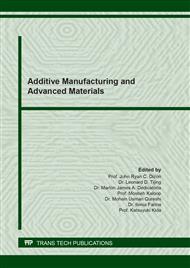p.241
p.247
p.259
p.265
p.271
p.279
p.287
p.293
p.301
Inverse Method for Estimation of Thermophysics Properties of a Bimaterials
Abstract:
The aim of this study is to identify simultaneously the thermal conductivity tensor and the volume heat coefficient of a bimaterial (checkerboard) whose heat conduction obeys Fourier's law. This approach is validated by numerical simulation. The simulated temperature fields are obtained by the direct resolution heat conduction solved numerically by the finite element method formulation. To identify parameters, an inverse method is developed by using the finite element temperature approach (FEU-T) model fitting method based on the Levemberg-Marquardt algorithm. We validated the numerical procedure by using noiseless temperature fields at different time and space steps. The influence of the noise on the temperature fields is also studied and shows the efficiency of the inverse method. The results show that this procedure is not very sensitive to the number of elements (or space steps) and the number of time steps.
Info:
Periodical:
Pages:
287-291
Citation:
Online since:
March 2022
Price:
Сopyright:
© 2022 Trans Tech Publications Ltd. All Rights Reserved
Share:
Citation:


